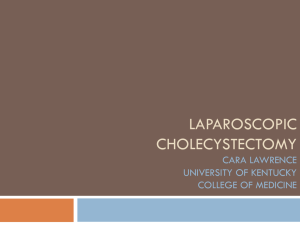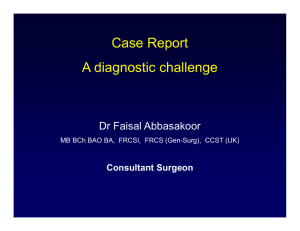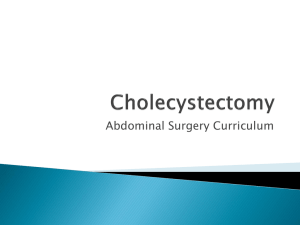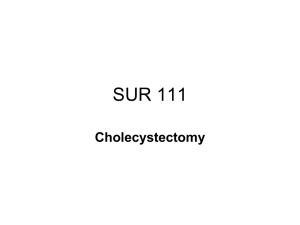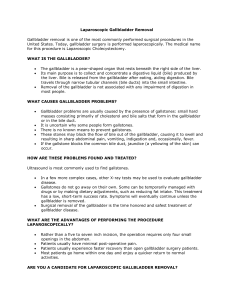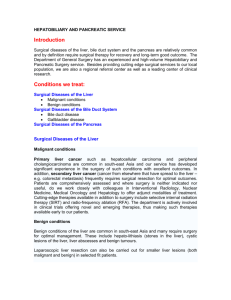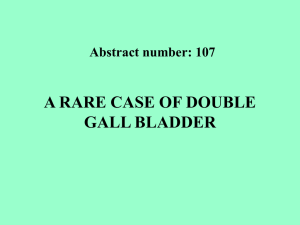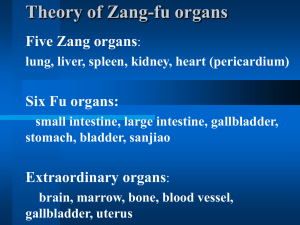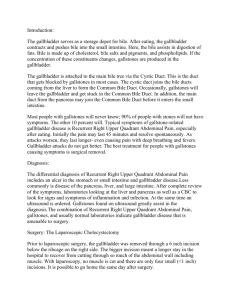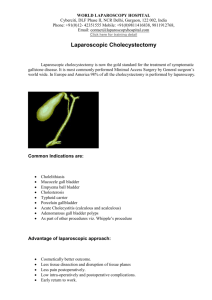*** 1
advertisement
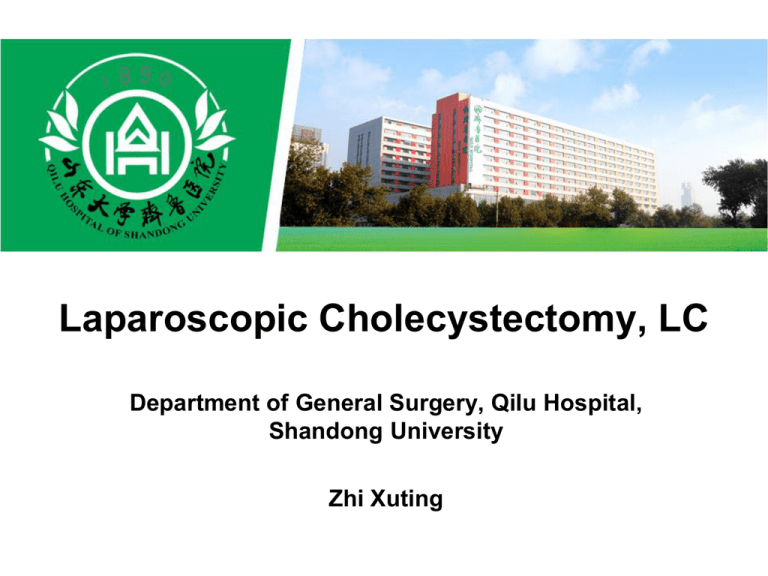
Laparoscopic Cholecystectomy, LC Department of General Surgery, Qilu Hospital, Shandong University Zhi Xuting Anatomy of biliary system Variation of cystic duct and cystic artery History, present and future of LC 1.The history of laparoscopic surgery (1) Diagnostic laparoscopy period(1901~1933) (2) Theraputic laparoscopy period(1933~1987) (3) Modern laparoscopic surgery period (1987~now) History, present and future of LC 2. The arrival of laparoscopic surgery era. 1987.3.15 A memorable day on which Phillipe Mouret from Lyon, France carried out the world's first laparoscopic cholecystectomy. 1988 Dubois from Paris and Perissat from Bordeaux learned LC from Mouret, and started to promote this technique in France, which subsequently shock the world. The history of laparoscopic surgery in China 1.At the end of 1990, LC started to be carried out in Hongkong; 2. In January,1991, doctors from First Hospital Affiliated to Guangdong Medical College started to carry out LC with the help of doctors from HK; 3.In February,1991,Xun Zuwu from the Second People's Hospital of Qujing,Yunnan completed the first LC of mainland. The history of laparoscopic surgery in Qilu Hospital We started to carry out LC from February,1992. Then the technique was subsequently adopted by surgeons from departments of gynaecology, urology, pediatric surgery and thoracic surgery. Many operations which can only be completed by open approach in the past, can now be completed by laparoscoy. Indications of Laparoscopic Cholecystectomy 1. Symptomatic gallstone ① Simple gallbladder stones ② Acute calculus cholecystitis ③ Gallbladder stones accompanied by gallbladder atrophy ④ Filled gallbladder stones ⑤ Gallbladder stones accompanied by history of abdominal operation ⑥ Gallbladder stones of special type (obesity/pregnancy/elderly/children) Indications of Laparoscopic Cholecystectomy 2. Silent gallbladder stones 3. Acalculus cholecystitis 4. Gallbladder stones accompanied by common bile duct stones Indications of Laparoscopic Cholecystectomy 5. Polypoid lesions of gallbladder (PLG) ① Cholecystic polypus (inflammatory/cholesterol/adenomatous) ② Gallbladder cancer of early stage ③ Pseudotumor of gallbladder (cholesterolosis of gallbladder/ gallbladder adenomyomatosis) Contraindications of Laparoscopic Cholecystectomy 1. 2. 3. 4. 5. 6. 7. 8. 9. Acute cholangitis of severe type (ACST) Severe infection of abdominal cavity Severe bleeding tendency Severe cirrhosis and portal hypertension Diaphragmatic hernia Severe organic dysfunction Gallbladder-intestine fistula Advanced gallbladder cancer Mirizzi syndrome Preoperative preparations of LC 1. General preparations History review; physical examinations; Ultrasound/ CT/ MRI examinations 2. Special preoperative preparations Skin preparations; fasting; preoperative medication ,etc 3. Forecasting the difficulty of operation Body weight; complications; operation history, cardiac and pulmonary function etc Basic procedures of LC 1. Anesthesia: general anesthesia 2. Positioning of patients and standing position of surgeons 3. Skin disinfection and draping 4. Establishment of pneumoperitoneum (closed or open) 5. Placement of trocar: (3 or 4 pores) 6. Laparoscopic exploration 7. Management of Calot's triangle Basic procedures of LC 8. Management of cystic duct and cystic artery 9. Dissecting and resection of gallbladder 10. Hemostasis of gallbladder bed and abdominal irrigation 11. Taking out the gallbladder 12. Abdominal drainage? 13. Turning off pneumoperitoneum and suturing incisions Schematic diagram of operation Ports sites Placement of trocars and exposure of gallbladder Dissecting Calot's triangle, severing cystic duct and cystic artery Dissecting and resection of gallbladder Taking out gallbladder Conversion to open surgery immediately According to opportunity postponed Types of conversion intended According to reason forced Reasons for conversion to open surgery • 1. Complicated conditions of illness • 2. Intraoperative complications that can not be dealt by laparoscopy • 3. Preoperative missed diagnosis and misdiagnosis • 4. Patient not being able to bear pneumoperitoneum • 5. Malfunction of equipment that can not be repaired within a short time • 6. Surgeons not being qualified for LC Strategies that help to reduce conversion rates • 1. Increase the training of basic laparoscopic skills • 2. Controll the indications of laparoscopic surgery • 3. Pay attention to preoperative diagnosis Complications of LC 1. Bile duct injury and biliary leakage 2. Intraoperative and postoperative haemorrhage of cystic artery 3. Residual calculus of common bile duct 4. Other complications: ① Titanic clip migration ② Postcholecystectomy syndrome and residual calculus of cystic duct ③ Postoperative pseudoaneurysm of hepatic artery ④ Haemorrhage of biliary duct Assessment of LC 1.Advantage 2.Disadvantage 3. Comprehensive assessment LC vs OC cost-effect analysis risk- effect analysis LC has become the golden standard for the treatment of benign lesions of gallbladder
